Kerhonkson-Based Stone Fabricator Barra & Trumbore Boasts Two Decades Experience
From Countertops to Vanities, Your Upstate Source for Natural and Manmade Stone
By Joan Vos MacDonald | Winter 2022 | The Source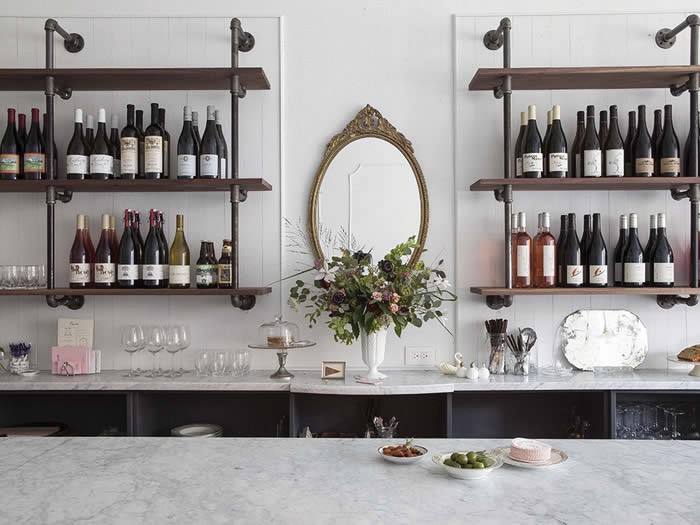
Stone has served essential design functions since antiquity. This durable, elegant building material is timeless, fitting into design schemes that range from Mid-Century Modern to farmhouse rustic. Each slab has its own distinctive appeal and there’s an abundance of stone to choose from—including several varieties found in the Hudson Valley.
“There are hundreds and hundreds of options for natural stone and manmade—quartz—varieties,” says David Barra of Kerhonkson-based Barra and Trumbore. Barra and business partner Martin Trumbore have been fabricating stone for over two decades. The duo first opened a shop in Tillson in 1996 and expanded their business with a move to a larger space in Kerhonkson in 2000.
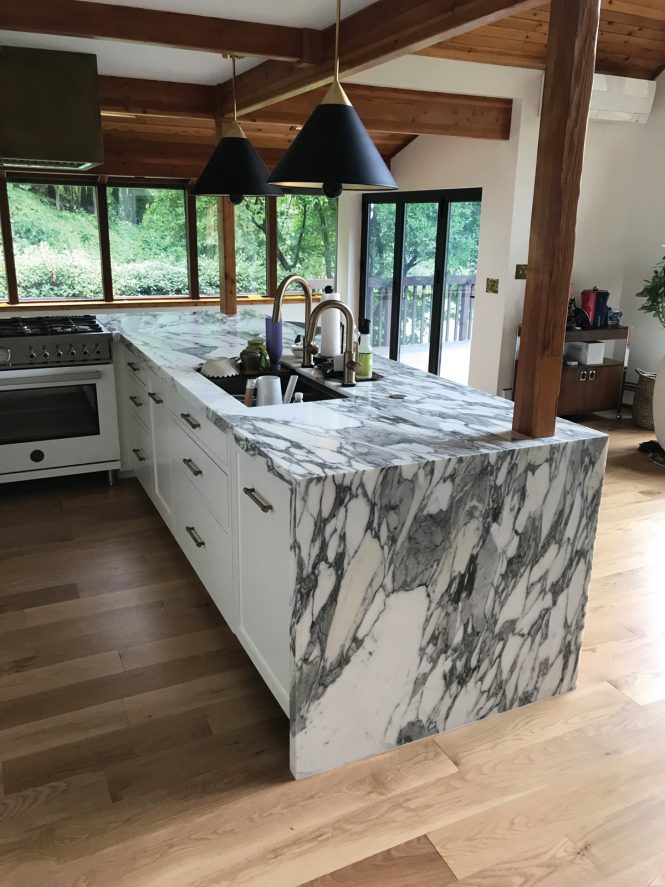
Marble peninsula with waterfall edge
“We both have carpentry/woodworking backgrounds and began to supplement cabinetry and furniture with stone in the early `90s,” says Barra. “There was certainly a fair amount of trial and error in the beginning when we used hand tools exclusively for fabrication. Our shop grew organically, and we continue to acquire new machinery to streamline the production process.”
Barra and Trumbore recognize the importance of guiding customers through the selection process because there really is a lot to consider. For a start, it’s important to find the most suitable stone for the project at hand. Hard stone, such as granite, may be ideal for kitchen work surfaces, while relatively softer stones, such as marble or limestone, are better suited for use in bathroom vanities. Polished stone looks luxurious and resists stains, but is also prone to scratches, while honed stone may be more scratch resistant, but is vulnerable to stains.
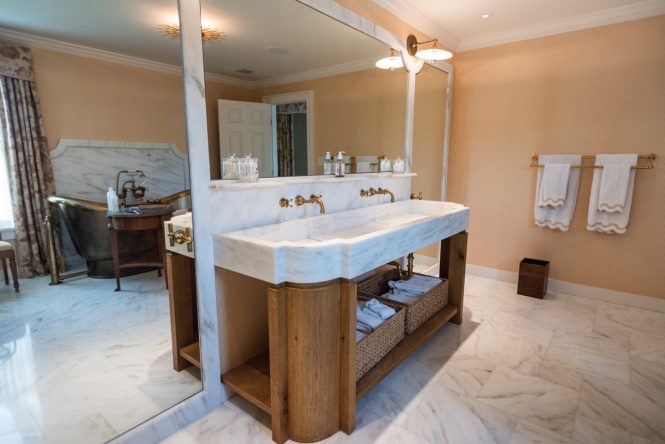
Marble peninsula with waterfall edge
According to Barra, certain varieties will age and patina with use and time. “We work with all varieties of natural stone—granite, marble, schist, quartzite, limestone, bluestone, slate, travertine, onyx, serpentine, basalt, soapstone, etc.—and manmade materials—quartz, terrazzo, richlite, paperstone, porcelain, etc.,” says Barra. “Soapstone and white marble continue to be perennial favorites of the Hudson Valley.”
The most common requests Barra and Trumbore receive are for stone sinks, vanity tops, and tub surrounds, but, with state-of-the-art technology, stone applications can extend far beyond kitchen and bath projects. Stone can be used for large format slab flooring, wainscoting, profile moldings, and furniture. Many stone varieties are freeze/thaw stable, making them ideal for exterior use.
“Anything is possible with a variety of stone and cutting-edge cutting technology,” he says. “We made a Blue Pearl granite hot tub for a residence in Poughkeepsie. This same residence had a fire sculpture that incorporated Black Galaxy granite as a reflecting element.”
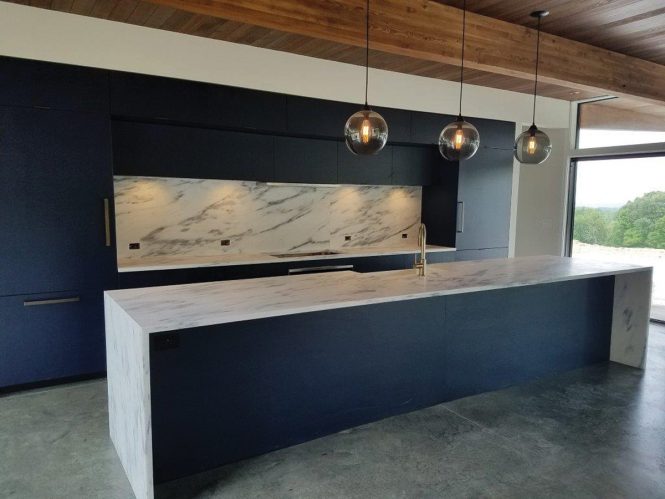
There are environmental factors to consider when employing stone for home design. If properly cared for, stone features will not need to be replaced during a homeowner’s lifetime and thus not wind up in a landfill. However, the quarrying, transport, and fabrication of stone do have an environmental impact. “I think it’s safe to assume that North American and European quarrying are subject to more strict environmental regulations than other regions,” says Barra. “In practice, stone blocks are often shipped around the world for processing. Large ocean vessels need ballast, so the blocks are desirable cargo.”
Barra and Trumbore considered the environmental impact of stone fabrication when designing their Kerhonkson workspace and invested in technology that would help offset the effects. Water is an essential part of stone cutting, polishing and finishing, so the company installed a high-pressure water recycling system to reduce their water consumption by more than 95 percent. All the fabrication done in the shop is done wet, in order to reduce airborne matter and keep the diamond tooling cool.
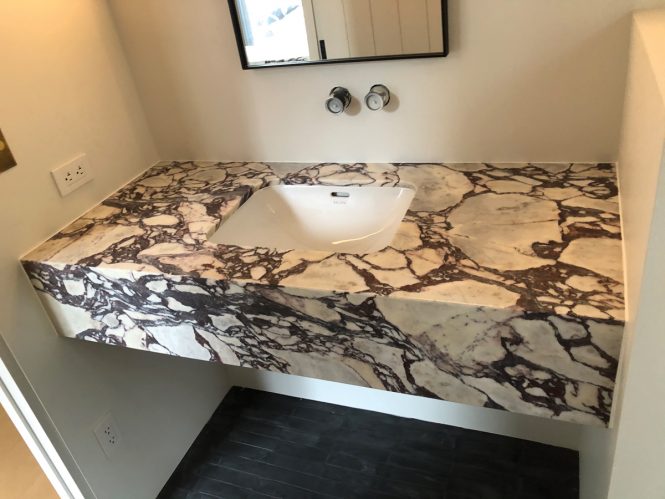
“We don’t have much influence on quarrying practices,” says Barra. “But we do whatever we can on our end to minimize our environmental impact. We’ve been solar since March 1, 2011.” The company’s photovoltaic system generates more electricity than is needed and the excess is fed back into the grid, effectively offsetting the power that’s used to fabricate stone.
Barra and Trumbore also work with engineered stone, an environmentally friendly option made largely from quartz, the second most abundant material on earth. It’s easier to source locally and potentially recyclable. Engineered stone is ideal for high-wear uses such as kitchen countertops.
Opting to use stone quarried in the area is an environmentally sensitive choice. The firm uses local stone whenever possible—working with local quarries to find Danby marbles, Virginia Mist granite, Onondaga limestone, slates and bluestone, effectively cutting down on the environmental impact of transporting the stone.
Many of the firm’s perennial favorites are quarried close by, offering a smart sustainable solution for Hudson Valley home design needs.
